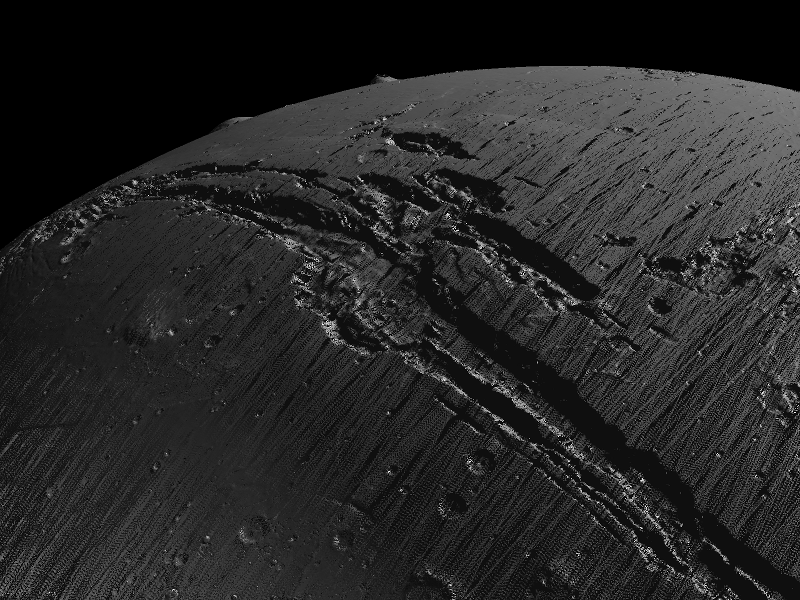I have talked about KeckCAVES’ involvement in the Curiosity Mars Rover missions several times before, but I just found a set of cool pictures that I have not shared yet. I just saw a reddit thread about a VR application to walk on the moon, one commenter asked about doing the same for Mars, and one thing led to another.
Can an application like that be done for Mars? Do we have enough data, and are the data publicly available? The answers are “yes, already done,” “kinda,” and “yes, but,” respectively.
As of my last checking, there are two main sources of topography data for Mars. The older source is an orbital laser range survey done by the Mars Orbiter Laser Altimeter (MOLA). This is essentially a planetary LiDAR scan, and can be visualized using LiDAR Viewer. The two pictures I mention above are these (Figures 1 and 2):

Figure 1: Global visualization of Mars topography using the MOLA data set, rendered using LiDAR Viewer. Vertical scale is 5:1.

Figure 2: Close-up of global Mars topography data set (centered on the canals), showing individual laser returns as grey dots. The scan lines corresponding to individual orbital periods can clearly be identified. Vertical scale is 5:1.
The MOLA data set is publicly available, and can be downloaded. It is fairly high-resolution, as can be seen from Figures 1 and 2, but it is not high-resolution enough for 1:1 scale visualization, i.e., for virtual strolls along the Martian landscape. The data are stored in a NASA-proprietary format, but there is a detailed (some might call it unreadable) data format specification, and 3D point return data is somewhat straightforward to extract.
The second data source is the HiRISE (High Resolution Imaging Science Experiment) camera mounted on the Mars Reconnaissance Orbiter (MRO). HiRISE is a 0.5m reflecting telescope (the largest ever carried on a deep space mission), and can take pictures with horizontal resolution of approximately 0.3m from about 300km orbital altitude. Even better, HiRISE is a stereo camera: it can be rotated out of its nadir orientation to take pictures at oblique angles, which can then be combined with nadir pictures of the same area to extract topography to a resolution of 0.25m. See Figure 3 for an example of the stunning images that get returned by HiRISE.

Figure 3: A color image of Gusev Crater, a potential landing site for a future NASA Mars rover mission planned for 2020, taken with the HiRISE camera on April 2, 2014. Image courtesy of NASA/JPL/University of Arizona.
Digital elevation models of 0.3m horizontal and 0.25m vertical resolution are definitely detailed enough for 1:1 terrain visualization and virtual walk-throughs, and have in fact been used for that exact purpose during Mars Curiosity Rover mission planning. Here is a short (3 minutes) documentary feature showing some of that (but see this previous post for some things that went wrong during filming). Beware ads: this is an official University of California video, but they put advertisements in front of it. Tacky. You have been warned:
There are only two problems with HiRISE: there is no global coverage (as should be expected, given the staggering amounts of data that would involve), and the existing images are somewhat hard to get. The data are public (any data that NASA produce enter the public domain), but that doesn’t mean anybody is working hard on making them easily accessible. There is an image catalog at the HiRISE web site, but good luck finding data about a specific area of interest, especially stereo pairs and topography data (Digital Terrain Models, DTMs).


This is the data you’re talking about right, in .b format?
http://pds-geosciences.wustl.edu/mgs/mgs-m-mola-1-aedr-l0-v1/mgsl_1xxx/data/aa10xxx/
Did you batch convert them into something readable by Lidar Viewer or how exactly did you go about?
I think that’s the wrong data set. It might be the gridded version, which removes much of the raw data. It has been a while, but I think you want the MOLA PEDR files, which contain raw laser alitmeter samples. Those can be converted into 3D point cloud input files for LiDAR Viewer.
Edit: Sorry, my bad. AEDR are the raw-raw instrument read-outs, which need to be converted into usable measurements based on instrument know-how only NASA has. You definitely want PEDR.
And yes, I wrote a small C++ tool to convert the PEDR files into a binary point file for LidarPreprocessor.
Darn, I guess this means programmers-only on Mars.
There is also the High Resolution Stereo Camera (HRSC) aboard the European Space Agency’s Mars Express spacecraft. The resolution sits somewhere between MOLA and HiRISE.
Thanks! I’ll check it out.
Hi I’m looking to combine MOLA with pieces of HiRISE data to create highly detailed and accurate pieces of terrain. I have been toying with all kinds of files and software to get this to work but hitting a brick wall. Do you have any tips you can share? I’m looking on creating an interactive 3D environment.
Thanks!
You might want to check out the USGS Digital Elevation Models of Mars. They have various ones derived from HiRISE data. For example, they have the ‘Spirit’ landing site at around 1m resolution and you can then use the source image (around 30cm) to provide a texture / albedo map.
The GDAL library is quite useful for manipulating this dataset
I used this data to create a virtual version of the spirit landing site in the PANGU planet surface simulation tool for my PhD studies.
Happy to provide further info if needed. You can PM me at <email address>.
Hi Mark,
I have emailed you.
Thanks!